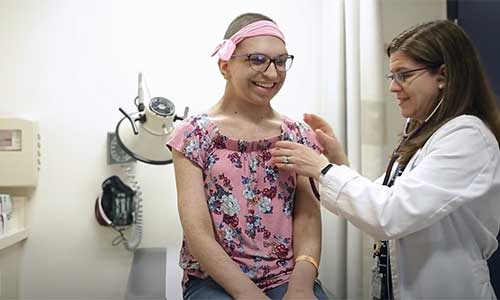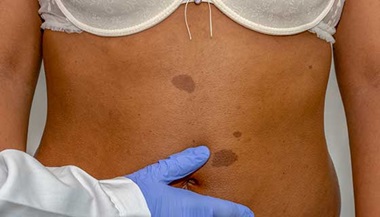Schwannomatosis
What You Need to Know
- Schwannomatosis is a rare form of neurofibromatosis (NF) that causes multiple nerve sheath tumors called schwannomas.
- Schwannomatosis affects about one in 40,000 people. It is diagnosed most often in people over age 30.
- The condition is genetic. About 15% of people with schwannomatosis inherited it, and the rest developed the condition due to a change to their genes.
- Schwannomatosis is not cancer, but sometimes a schwannoma can become a malignant nerve sheath tumor.
What is schwannomatosis?
Schwannomatosis, a type of neurofibromatosis, is a rare genetic disorder that results in multiple tumors (called schwannomas) that grow on the coverings of peripheral nerves throughout the body and can cause debilitating pain and neurological dysfunction.
Symptoms of Schwannomatosis
The most urgent symptom of schwannomatosis is intense pain, which can occur when a schwannoma grows and presses on a nearby nerve or other tissue. This can happen anywhere in the body, and some patients have symptoms in multiple areas. For some, it is not easy to identify the cause of the pain.
If a schwannoma presses on the spinal cord, it can cause other symptoms such as:
- Numbness
- Tingling
- Weakness
Depending on the location of the tumors, people with schwannomatosis may also experience:
- Difficulty urinating or bowel dysfunction
- Facial weakness
- Headaches
- Lumps or swollen areas where tumors form under the skin
- Numbness
- Vision changes
- Weakness
Schwannomatosis Diagnosis
The diagnostic criteria for schwannomatosis follows strict guidelines. Only a doctor with expertise in schwannomatosis can provide an accurate diagnosis, which may be established if a person meets one of the conditions below.
A confirmed (definite) diagnosis of schwannomatosis can be made in either of the following cases.
- The person is age 30 or older and has all of the following:
- Two or more nonintradermal schwannomas (schwannoma tumors located somewhere other than the skin), and at least one of these tumors is confirmed with tissue examined under a microscope
- No evidence of a tumor in the vestibule of the inner ear on high quality MRI scan
- No known physical or genetic signs of NF2
- No first-degree relative with NF2, or
- One nonvestibular schwannoma confirmed by a pathologist, plus a first degree relative who meets the above criteria for schwannomatosis
Possible Diagnosis of Schwannomatosis
- The person is age 30 or older and:
- Has two or more nonintradermal schwannomas (schwannoma tumors located somewhere other than the skin), and at least one of these tumors is confirmed with microscopic examination of tumor tissue
- No evidence of vestibular tumor on high quality MRI scan
- No first-degree relative with NF2
- No known NF2 mutation
- Age greater than 45 and no symptoms of dysfunction of the eighth cranial nerve, which is in the inner ear (symptoms of dysfunction include issues with hearing and balance)
- Radiographic evidence (imaging scans) of a nonvestibular schwannoma, plus a first degree relative who meets the criteria for definite schwannomatosis
What causes schwannomatosis?
In some families, more than one member has been diagnosed with schwannomatosis, and 15% of people with the condition inherited it. This is referred to as a familial case of schwannomatosis.
In other families, only one person has been diagnosed with schwannomatosis. This is referred to as a sporadic case of the condition. Some people have features of schwannomatosis that are limited to only one part of their body. This is called segmental or mosaic schwannomatosis.
Schwannomatosis can also occur in people without affected family members. Changes in one of two genes — SMARCB1 or LZTR1 — are often found to be the cause of schwannomatosis, and these changes (mutations) can happen spontaneously. SMARCB1 and LZTR1 are genes that prevent cells from growing out of control and forming tumors. When they don’t work as they should, schwannomas can form in the body.
Is genetic testing for schwannomatosis available?
Testing for genetic changes is available for people interested in having children who might be affected. For people with mosaic schwannomatosis, genetic testing can be more complex. It is a good idea for anyone with questions about the risk of developing schwannomatosis and about genetic testing to meet with a genetic counselor to learn more about their case.
Schwannomatosis Treatment
There is no cure for schwannomatosis, but treatments are available to help manage symptoms. Schwannomatosis treatment may require surgery depending on the symptoms.
Nonoperative treatment for schwannomatosis may include observation, periodic imaging and pain management, and is often used for tumors that cannot be removed surgically.
Surgical removal of schwannomas may be recommended when it can provide significant symptom relief. These procedures should be performed by an expert in operating on these tumors to minimize the risk of nerve damage. When surgery is successful, 95% of tumors do not return. Those that do recur may appear years after surgical removal of the schwannoma.
NF Care at Johns Hopkins

The Johns Hopkins Comprehensive Neurofibromatosis Center is one of the few specialized centers in the world helping patients with NF1, NF2 and schwannomatosis. Our multi-specialty team uses the latest treatment approaches that aim to address all aspects of living with NF.






